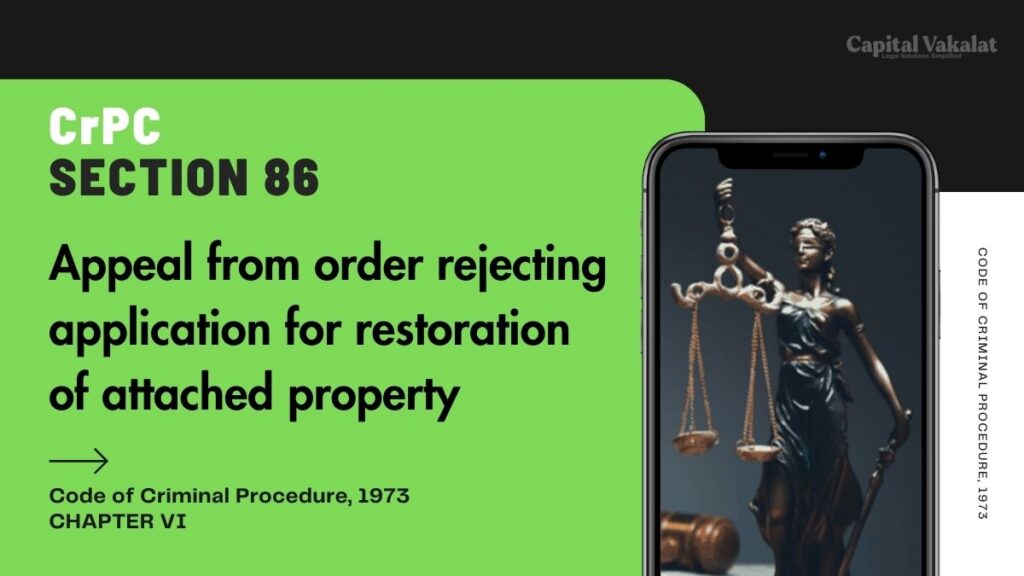Section 86 of the Criminal Procedure Code (CrPC) provides a crucial legal remedy for individuals seeking redressal after their applications for restoration of attached property have been rejected.

This section serves as an appeal mechanism, offering a lifeline to property owners who believe that their rights have been unjustly overlooked by the initial adjudicating authority.
Bare Act. Section 86 Cr.P.C.
Appeal from order rejecting application for restoration of attached property.
Any person referred to in sub-section (3) of section 85, who is aggrieved by any refusal to deliver property or the proceeds of the sale thereof may appeal to the Court to which appeals ordinarily lie from the sentences of the first-mentioned Court.
Historical Context of Section 86 CrPC
The origins of Section 86 CrPC can be traced back to the colonial period when the British legal system sought to establish a structured mechanism for property-related disputes in India. Over the years, the provision has evolved to align with contemporary legal standards and ensure that due process is upheld in property attachment and restoration cases. Understanding this historical context is vital for appreciating the safeguards embedded within the CrPC, designed to protect property owners against arbitrary state actions.
Understanding Attached Property Under CrPC
Criteria for Property Attachment Under CrPC
Property attachment under the CrPC is typically pursued when there is a suspicion that the property is linked to a crime, such as proceeds of crime, or if the property owner is absconding, making it necessary to secure the property. The criteria for attachment are stringent, requiring substantial evidence and adherence to due process, including issuing notices and providing opportunities for the property owner to present their case.
Process of Property Attachment
The process of property attachment involves several steps, starting with the issuance of an attachment order by a competent authority. This order is followed by the physical attachment of the property, which is often carried out by law enforcement agencies. The property owner is then notified, and they are given a chance to contest the attachment through legal channels.
Filing an Application for Restoration
Grounds for Filing Restoration Application
An application for the restoration of attached property can be filed on various grounds, including proving that the property was wrongfully attached or that the legal requirements for attachment were not fully complied with. The applicant must demonstrate that the attachment was either procedurally flawed or substantively unjustified.
Judicial Review of Restoration Application
Once an application for restoration is filed, it undergoes judicial scrutiny. The reviewing authority examines the merits of the case, including the evidence presented by both the applicant and the state. The aim is to determine whether the attachment was warranted and if the restoration application has valid grounds.
Typical Grounds for Rejection of Restoration Application
Inadequate Evidence
One of the primary reasons for rejecting a restoration application is the lack of adequate evidence. Applicants must provide compelling proof to substantiate their claims, and failure to do so can result in the dismissal of their application.
Procedural Non-Compliance
Applications may also be rejected if there are procedural deficiencies, such as not adhering to the specified timeline for filing or failing to follow the prescribed format.
Appeal Process Under Section 86 CrPC
Legal Framework for Appeals
Section 86 CrPC outlines the legal framework for appealing orders that reject restoration applications. The appeal must be filed within a stipulated period, and the appellate court examines the case afresh, considering the arguments and evidence presented.
Preparing for an Appeal
Essential Documents for Appeal
Preparing for an appeal under Section 86 CrPC requires meticulous attention to detail. Essential documents include the original attachment order, the restoration application, the rejection order, and any additional evidence that supports the appeal. Proper documentation is crucial for a successful appeal.
Role of Legal Representation in Appeals
Navigating the complexities of an appeal requires skilled legal representation. Choosing the right lawyer, one who has expertise in criminal law and experience with property attachment cases, can significantly influence the outcome of the appeal.
Possible Outcomes of an Appeal
Success Rates and Case Studies
The outcomes of appeals under Section 86 CrPC can vary. While some appeals result in the restoration of attached property, others may uphold the original rejection order. Reviewing case studies and success rates can provide insights into the factors that contribute to successful appeals.
Conclusion
Final Thoughts on Section 86 CrPC
Section 86 CrPC plays a pivotal role in safeguarding the rights of property owners, offering a structured appeal mechanism for those whose restoration applications have been denied. Understanding the intricacies of this legal provision is essential for effectively navigating the appeal process and ensuring that justice is served. With the right legal representation and thorough preparation, appellants can enhance their prospects of a favorable outcome.
Frequently Asked Questions
How do I file an appeal under Section 86 CrPC?
To file an appeal, you must submit a formal appeal application to the appellate court within the specified time frame. This application should include all relevant documents and evidence to support your case.
What are the common reasons for the rejection of restoration applications?
Common reasons include inadequate evidence, procedural non-compliance, and failure to demonstrate that the attachment was unjustified or procedurally flawed.
What documents are required for filing an appeal?
Essential documents include the original attachment order, the restoration application, the rejection order, and any supporting evidence.
How important is legal representation in the appeal process?
Legal representation is crucial for navigating the complexities of the appeal process. An experienced lawyer can provide valuable guidance and increase the chances of a successful appeal.
What are the possible outcomes of an appeal under Section 86 CrPC?
Possible outcomes include the restoration of attached property, upholding the original rejection order, or further legal actions depending on the specifics of the case.